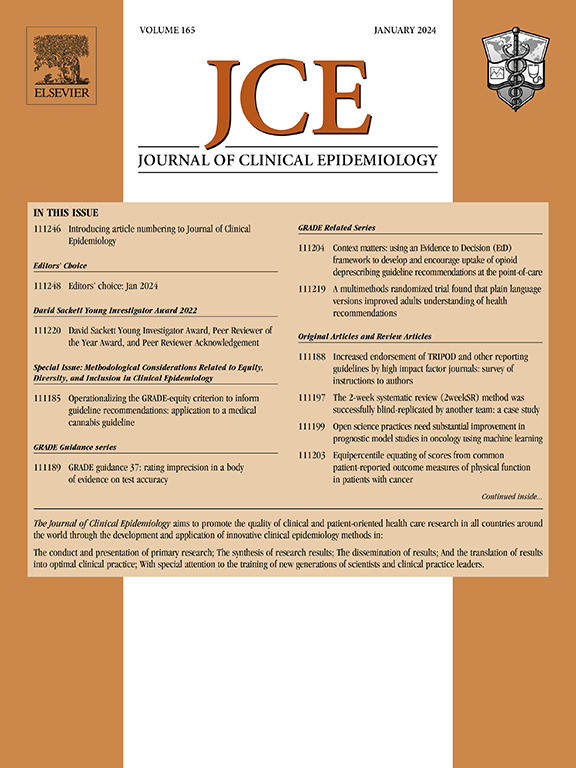对引用COMET结果分类法的研究的意见进行分析,支持将其用于卫生研究:描述性研究。
IF 5.2
2区 医学
Q1 HEALTH CARE SCIENCES & SERVICES
引用次数: 0
摘要
目标:为了支持将彗星分类用于健康结果,必须在早期试点阶段之外更广泛地评估其适用性和适用性。证明其在实践中的适用性将进一步支持将其用于帮助制定核心成果集、系统审查和在线资源搜索,从而帮助知识传播。研究设计和设置:引用分析确定了已发表的应用该分类法的研究。对这些出版物进行分析的目的是了解出版物的类型、临床领域、使用或调整分类法的原因,以及应用该分类法的研究人员的任何评论。结果:在确定的315篇论文中,抽样了200篇,分析了涉及184个项目的193篇出版物。近三分之一(58.30%)的出版物与核心结果集的开发有关,一半(98.51%)与综述(系统、范围界定和文献)的开发有关。在三分之二(123.67%)的项目中,分类法被用于对健康结果进行分类,其中绝大多数(117.95%)的项目在没有做任何改变的情况下这样做了。结论:本研究证实,该分类法对于卫生研究中所有患者结果的分类是足够全面和细致的。它的应用可以突出对患者最重要的结果缺乏关注。我们鼓励采用这种分类系统,以方便证据检索。本文章由计算机程序翻译,如有差异,请以英文原文为准。
Analysis of opinions from studies citing use of Core Outcome Measures in Effectiveness Trials outcomes taxonomy supports it use in health research: descriptive study
Objectives
To support the use of the Core Outcome Measures in Effectiveness Trials taxonomy for health outcomes, its suitability and applicability must be assessed more broadly beyond that of its early piloting phases. Demonstration of its suitability in practice would provide further support for its use in aiding the development of core outcome sets (COS), systematic reviews, and searching in online resources, thereby aiding knowledge dissemination.
Study Design and Setting
A citation analysis identified published studies where the taxonomy had been applied. Analysis of these publications aimed to understand the type of publication, clinical area, reason for taxonomy use or adaptation, and any comments made by researchers who had applied the taxonomy.
Results
Of 315 papers identified, 200 were sampled and 193 publications relating to 184 projects were analyzed. Nearly one-third (58, 30%) of publications were related to the development of COS and half (98, 51%) were related to the development of reviews (systematic, scoping, and literature). In two-thirds (123, 67%) of the projects the taxonomy was applied for the classification of health outcomes and the vast majority (117, 95%) of these did so without making any changes.
Conclusion
This research confirms the taxonomy is sufficiently comprehensive and granular for the classification of all patient outcomes in health research. Its application can highlight a lack of attention being paid toward outcomes most important to patients. We encourage the adoption of this classification system to facilitate evidence searching.
Plain Language Summary
Patient health outcomes measure things that happen to patients relating to their health. These outcomes include clinical measures (such as blood pressure), life impact measures (such as effects on physical functioning), use of resources (such as number of hospital appointments), survival (such as how long someone survives after surgery), and harms (such as adverse events following treatment). In 2018, we developed a classification system (called a taxonomy) to help researchers organize the types of outcomes that they are collecting (perhaps when carrying out a clinical trial) or reporting (eg, when combining results from many studies in a systematic review). This taxonomy was designed to help researchers to more clearly present their results, as well as to allow them to search for outcomes online in a more organized manner. We used outcomes taken from many trials and reviews when developing the taxonomy, to make sure that all types of outcomes were covered, but we wanted to make sure that researchers found the taxonomy helpful in practice. This study has been carried out to understand the opinions of researchers who mentioned the taxonomy in their publications, to find out whether they thought any types of outcomes were missing. The study found that researchers found the taxonomy useful, either to classify their research outcomes or because they found our definitions of the different types of outcomes useful. Sometimes researchers wanted to be able to classify “who” reported the outcomes (such as patients) or wanted more specific definitions of the different types of outcomes included. We would encourage them to create subcategories within our taxonomy categories to cover these outcome features. A few researchers felt that they needed to add some extra outcome types, but this was because they did not realize that these outcomes would fit within one of the existing taxonomy groups. In summary, this study found that the taxonomy is useful to researchers to classify “what” patient health outcomes are recorded in their studies, and researchers are very welcome to contact us if they have any questions about how to use it or how to classify particular outcomes.
求助全文
通过发布文献求助,成功后即可免费获取论文全文。
去求助
来源期刊

Journal of Clinical Epidemiology
医学-公共卫生、环境卫生与职业卫生
CiteScore
12.00
自引率
6.90%
发文量
320
审稿时长
44 days
期刊介绍:
The Journal of Clinical Epidemiology strives to enhance the quality of clinical and patient-oriented healthcare research by advancing and applying innovative methods in conducting, presenting, synthesizing, disseminating, and translating research results into optimal clinical practice. Special emphasis is placed on training new generations of scientists and clinical practice leaders.
 求助内容:
求助内容: 应助结果提醒方式:
应助结果提醒方式:


